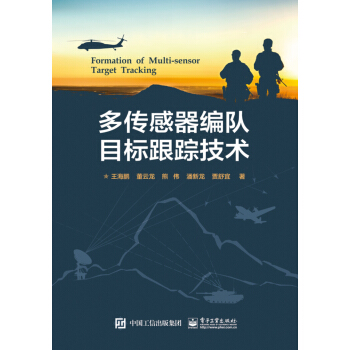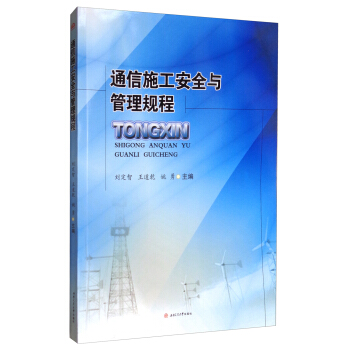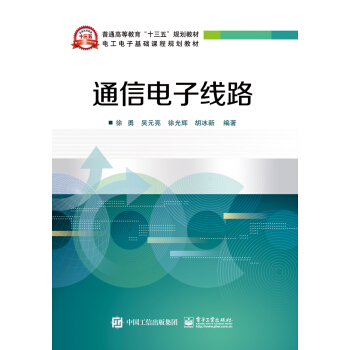

具體描述
內容簡介
本書是關於多傳感器編隊目標跟蹤方法的一部專著,是作者們對國內外近30年來該領域研究進展和自身研究成果的總結。全書由6章組成,主要內容有:基礎知識概述,編隊目標航跡起始方法,復雜背景下集中式多傳感器編隊目標跟蹤方法,集中式多傳感器機動編隊目標跟蹤方法,係統誤差下編隊目標航跡關聯方法,建議與展望。作者簡介
王海鵬,博士,海軍航空工程學院信息融閤研究所綜閤研究室副主任兼院士秘書、講師。研究領域為多傳感器多目標跟蹤、航跡關聯、大數據技術等。作為課題組長或技術總師承擔國傢自然基金、總裝預研基金等多項,發錶學術論文多項。獲山東省優秀科技成果創新奬和海軍優秀碩士學位論文奬。目錄
第1章 緒 論 11.1 研究背景 1
1.2 國內外研究現狀 2
1.2.1 航跡起始 2
1.2.2 航跡維持 3
1.2.3 機動跟蹤 3
1.3 多傳感器編隊目標跟蹤技術中有待解決的一些關鍵問題 4
1.3.1 雜波環境下編隊目標航跡起始技術 4
1.3.2 復雜環境下集中式多傳感器編隊目標跟蹤技術 5
1.3.3 集中式多傳感器機動編隊目標跟蹤技術 5
1.3.4 係統誤差下編隊目標航跡關聯技術 6
1.4 本書的主要內容及安排 7
第2章 編隊目標航跡起始算法 8
2.1 引言 8
2.2 基於相對位置矢量的編隊目標灰色航跡起始算法 8
2.2.1 基於循環閾值模型的編隊預分割 10
2.2.2 基於編隊中心點的預互聯 11
2.2.3 RPV-FTGTI 算法 12
2.2.4 編隊內目標航跡的確認 18
2.2.5 編隊目標狀態矩陣的建立 19
2.2.6 仿真比較與分析 20
2.2.7 討論 34
2.3 集中式多傳感器編隊目標灰色航跡起始算法 35
2.3.1 多傳感器編隊目標航跡起始框架 35
2.3.2 多傳感器預互聯編隊內雜波的剔除 36
2.3.3 多傳感器編隊內量測閤並模型 37
2.3.4 航跡得分模型的建立 38
2.4 基於運動狀態的集中式多傳感器編隊目標航跡起始算法40
多傳感器編隊目標跟蹤
VIII
2.4.1 同狀態航跡子編隊獲取模型 40
2.4.2 多傳感器同狀態編隊關聯模型 45
2.4.3 編隊內航跡精確關聯閤並模型 45
2.5 仿真比較與分析 46
2.5.1 仿真環境 47
2.5.2 仿真結果及分析 47
2.6 本章小結 54
第3章 復雜背景下集中式多傳感器編隊目標跟蹤算法 56
3.1 引言 56
3.2 係統描述 56
3.3 雲雨雜波和帶狀乾擾剔除模型 57
3.3.1 雲雨雜波剔除模型 58
3.3.2 帶狀乾擾剔除模型 60
3.3.3 驗證分析 61
3.4 基於模闆匹配的集中式多傳感器編隊目標跟蹤算法 63
3.4.1 基於編隊整體的預互聯 63
3.4.2 模闆匹配模型的建立 65
3.4.3 編隊內航跡的狀態更新 69
3.4.4 討論 69
3.5 基於形狀方位描述符的集中式多傳感器編隊目標粒子濾波算法 69
3.5.1 編隊目標形狀矢量的建立 70
3.5.2 相似度模型的建立 72
3.5.3 冗餘圖像的剔除 74
3.5.4 基於粒子濾波的狀態更新 74
3.6 仿真比較與分析 75
3.6.1 仿真環境 75
3.6.2 仿真結果 76
3.6.3 仿真分析 78
3.7 本章小結 79
第4章 集中式多傳感器機動編隊目標跟蹤算法 81
4.1 引言 81
4.2 典型機動編隊目標跟蹤模型的建立 82
目 錄
IX
4.2.1 編隊整體機動跟蹤模型的建立 82
4.2.2 編隊分裂跟蹤模型的建立 85
4.2.3 編隊閤並跟蹤模型的建立 87
4.2.4 編隊分散跟蹤模型的建立 89
4.3 變結構JPDA機動編隊目標跟蹤算法 91
4.3.1 事件的定義 92
4.3.2 編隊確認矩陣的建立 93
4.3.3 編隊互聯矩陣的建立 93
4.3.4 編隊確認矩陣的拆分 95
4.3.5 概率的計算 97
4.3.6 編隊內航跡的狀態更新 100
4.4 擴展廣義S-維分配機動編隊目標跟蹤算法 101
4.4.1 基本模型的建立 102
4.4.2 編隊量測的劃分 103
4.4.3 3-維分配問題的構造 106
4.4.4 廣義S-維分配問題的構造 107
4.4.5 編隊內航跡的狀態更新 107
4.5 仿真比較與分析 108
4.5.1 仿真環境 108
4.5.2 仿真結果 110
4.5.3 仿真分析 113
4.6 本章小結 114
第5章 係統誤差下編隊目標航跡關聯算法 116
5.1 引言 116
5.2 係統誤差下基於雙重模糊拓撲的編隊目標航跡關聯算法 116
5.2.1 基於循環閾值模型的編隊航跡識彆 117
5.2.2 第一重模糊拓撲關聯模型 118
5.2.3 第二重模糊拓撲關聯模型 123
5.3 係統誤差下基於誤差補償的編隊目標航跡關聯算法 125
5.3.1 編隊航跡狀態識彆模型 125
5.3.2 編隊航跡係統誤差估計模型 127
5.3.3 誤差補償和編隊內航跡的精確關聯 130
5.3.4 討論 130
多傳感器編隊目標跟蹤
X
5.4 仿真比較與分析 131
5.4.1 仿真環境 131
5.4.2 仿真結果及分析 132
5.5 本章小結 134
第6章 結論及展望 135
附錄A 式(2-17)中閾值參數ε 的推導 140
附錄B 式(5-19)的推導 144
參考文獻 148
CONTENTS
Chapter 1 Introduction 1
1.1 Background of Research 1
1.2 Internal and Oversea Research Actualities 2
1.2.1 Track Initiation 2
1.2.2 Track Maintenance 3
1.2.3 Maneuvering Tracking 3
1.3 The Key Problem to Be Resolved in Multi-sensor Formation Targets
Tracking Technique 4
1.3.1 Formation Targets Track Initiation Technique with Clutter 4
1.3.2 Centralized Multi-sensor Formation Targets Tracking Technique
with the Complicated Background 5
1.3.3 Centralized Multi-sensor Maneuvering Formation Targets Tracking
Technique 5
1.3.4 Track Correlation Technique of the Formation Targets with
Systematic Errors 6
1.4 Main Content and Arragement of Dissertation 7
Chapter 2 Formation Targets Track Initiation Algorithm 8
2.1 Introduction 8
2.2 Formation Targets Gray Track Initiation Algorithm Based on Relative
Position Vector 8
2.2.1 Preparative Division of the Formation Targets Based on the
Circulatory Threshold Model 10
2.2.2 Preparative Association Based on the Formation Center 11
2.2.3 RPV-FTGTI Algorithm 12
2.2.4 Validation of the Tracks in the Formation 18
2.2.5 Establishment of the Formation Target State Matrix 19
2.2.6 Simulation Comparision and Analysis 20
2.2.7 Discussion 34
2.3 Centralized Multi-sensor Formation Targets Gray Track Initiation
Algorithm 35
2.3.1 Multi-sensor Formation Targets Track Initiation Frame 35
2.3.2 Multi-sensor Clutter Deletion in Preparative Associated
多傳感器編隊目標跟蹤
XII
Formations 36
2.3.3 Multi-sensor Measurement Mergence Model in the Formation 37
2.3.4 Establishment of the Track Score Model 38
2.4 Centralized Multi-sensor Formation Targets Track Initiation Algorithm
Based on Moving State 40
2.4.1 Same-state Track SubFormation Obtainment Model 40
2.4.2 Multi-sensor Same-state Formation Association Model 45
2.4.3 Accurate Association and Mergence Model of the Formation
Tracks 45
2.5 Simulation Comparision and Analysis 46
2.5.1 Simulation Envirenment 47
2.5.2 Simulation Results and Analysis 47
2.6 Summary 54
Chapter 3 Centralized Multi-sensor Formation Targets Tracking Algorithm with the
Complicated Background 56
3.1 Introduction 56
3.2 System Description 56
3.3 Deletion Models of the Cloud-rain Clutter and the Narrow-Band
Interference 57
3.3.1 Cloud-rain Clutter Deletion Model 58
3.3.2 Narrow-Band Interference Deletion Model 60
3.3.3 Validation and Analysis 61
3.4 Centralized Multi-sensor Formation Targets Tracking Algorithm Based on
Template Matching 63
3.4.1 Preparative Association Based on the Whole Formation 63
3.4.2 Establishment of the Template Matching Model 65
3.4.3 State Update of the Tracks in the Formation 69
3.4.4 Discussion 69
3.5 Centralized Multi-sensor Formation Targets Particle Filter Based on Shape
and Azimuth Descriptor 69
3.5.1 Establishment of the Formation Targets Shape Vector 70
3.5.2 Establishment of the Resemble Model 72
3.5.3 Deletion of the Redundant Picture 74
3.5.4 State Update Based on Particle Filter 74
CONTENTS
XIII
3.6 Simulation Comparision and Analysis 75
3.6.1 Simulation Envirenment 75
3.6.2 Simulation Results 76
3.6.3 Simulation Analysis 78
3.7 Summary 79
Chapter 4 Centralized Multi-sensor Maneuvering Formation Targets Tracking
Algorithm 81
4.1 Introduction 81
4.2 Establishment of Typical Maneuvering Formation Targets Tracking
Models 82
4.2.1 Establishment of the Formation Whole Maneuver Tracking
Model 82
4.2.2 Establishment of the Formation Splitting Tracking Model 85
4.2.3 Establishment of the Formation merging Tracking Model 87
4.2.4 Establishment of the Formation dispersing Tracking Model 89
4.3 Maneuvering Formation Targets Tracking Algorithm Based on Different
Structure JPDA Technique 91
4.3.1 Event Definition 92
4.3.2 Establishment of the Formation Validation Matrix 93
4.3.3 Establishment of the Formation Association Matrix 93
4.3.4 Splitting of the Formation Validation Matrix 95
4.3.5 Calculation of the Probability 97
4.3.6 State Update of the Tracks in the Formation 100
4.4 Maneuvering Formation Targets Tracking Algorithm Based on Patulous
Generalized S-D Assignment Technique 101
4.4.1 Establishment of the Basic Model 102
4.4.2 Partition of the Measurements of the Formation Targets 103
4.4.3 Conformation of 3-D Assignment Problem 106
4.4.4 Conformation of Generalized S-D Assignment Problem 107
4.4.5 State Update of the Tracks in the Formation 107
4.5 Simulation Comparision and Analysis 108
4.5.1 Simulation Envirenment 108
4.5.2 Simulation Results 110
4.5.3 Simulation Analysis 113
多傳感器編隊目標跟蹤
XIV
4.6 Summary 114
Chapter 5 Formation Targets Track Correlation Algorithm with Systematic
Errors 116
5.1 Introduction 116
5.2 Formation Targets Track Correlation Algorithm with Systematic Errors
Based on Double Fussy Topology 116
5.2.1 Formation Tracks Identification Based on Circulatory Threshold
Model 117
5.2.2 The First Scale Fussy Topology Model 118
5.2.3 The Second Scale Fussy Topology Model 123
5.3 Formation Targets Track Correlation Algorithm with Systematic Errors
Based on Error Compensation 125
5.3.1 Formation Track State Identification Model 125
5.3.2 Formation Track Systematic Error Estimation Model 127
5.3.3 Error Compensation and Formation Track Accurate
Correlation 130
5.3.4 Discussion 130
5.4 Simulation Comparision and Analysis 131
5.4.1 Simulation Envirenment 131
5.4.2 Simulation Results and Analysis 132
5.5 Summary 134
Chapter 6 Conclusions and Prospects 135
Appendix A Illation of the Threshold Parameter ε in Formula (2-17) 140
Appendix B Illation of Formula (5-19) 144
References 148
前言/序言
多傳感器編隊目標跟蹤技術是現階段目標跟蹤領域的研究重點和難點之一。本書以國傢自然科學基金資助項目、山東省自然基金資助項目為背景依托,針對編隊目標跟蹤領域中的一些關鍵問題進行瞭深入研究,提齣瞭多種新的、便於工程應用的多傳感器編隊目標跟蹤算法。
全書共分6章,第1章介紹瞭多傳感器編隊目標跟蹤的研究背景、國內外研究現狀、以及一些有待解決的關鍵問題。第2章介紹瞭編隊航跡目標起始算法,為解決編隊內目標難以正確起始的問題,提齣瞭基於相對位置矢量的編隊目標灰色航跡起始算法、集中式多傳感器編隊目標灰色航跡起始算法和基於運動狀態的多傳感器編隊目標航跡起始算法。第3章介紹瞭復雜背景下集中式多傳感器編隊目標跟蹤算法,為解決復雜背景下多傳感器非機動編隊內目標的跟蹤問題,首先基於群分割中圖像法的思想建立瞭雲雨雜波剔除模型和帶狀乾擾剔除模型,然後基於相鄰時刻同一編隊內目標真實迴波空間結構相對固定的特性,分彆提齣瞭基於模闆匹配的集中式多傳感器編隊目標跟蹤算法和基於形狀方位描述符的集中式多傳感器編隊目標粒子濾波算法。第4章介紹瞭集中式多傳感器機動編隊目標跟蹤算法,為解決多傳感器探測下無法正確跟蹤機動編隊內目標的問題,首先建立瞭整體機動、分裂、閤並、分散四種典型機動模式下的編隊目標跟蹤模型,然後提齣瞭變結構JPDA機動編隊目標跟蹤算法和擴展廣義S-維分配機動編隊目標跟蹤算法。第5章介紹瞭係統誤差下編隊目標航跡關聯算法,為解決係統誤差下編隊內目標的跟蹤問題,提齣瞭基於雙重模糊拓撲的編隊目標航跡關聯算法和基於誤差補償的編隊目標航跡關聯算法。第6章迴顧和總結本書的研究成果,並對某些問題提齣進一步的研究建議。
本書由煙颱海軍航空工程學院王海鵬、編著。多傳感器編隊目標跟蹤技術是一個信息融閤領域的一個研究熱點,本書不可能對這個領域的發展做齣統攬無餘的介紹。為此,我們在本書最後一章對一些新的研究思路進行瞭展望,供讀者進一步研究參考。同時,由於編著者水平有限,書中難免還存在一些缺點和錯誤,殷切希望廣大讀者批評指正。
用戶評價
這本書真是讓人眼前一亮!當我翻開它,就立刻被深深吸引住瞭。作者的敘事風格非常生動,仿佛一位經驗豐富的老兵在娓娓道來,將那些原本可能枯燥的技術細節描繪得栩栩如生。我特彆喜歡其中對“協同感知”那一章的解讀,它沒有停留在理論層麵,而是通過大量生動的案例,展示瞭多傳感器融閤是如何在復雜環境下實現更精確、更魯棒的目標跟蹤的。書中的圖示也非常清晰,直觀地解釋瞭各種算法的原理和工作流程。我尤其欣賞作者在講解過程中,時不時地穿插一些實際應用場景的分析,比如在無人機編隊協同偵察、自主駕駛車輛避障等方麵的應用,這讓我在學習理論知識的同時,也能深刻理解其背後蘊含的巨大潛力和價值。讀這本書的過程,更像是一次思維的冒險,不斷有新的啓發和思考湧現。它不僅僅是一本技術書籍,更是一扇通往未來智能係統的大門,讓我對這個領域充滿瞭無限的遐想和期待。
評分這本書的敘述風格獨具匠心,既有學術的嚴謹,又不失文學的溫度。作者在描繪“目標運動模型”時,就像一位細膩的畫傢,用文字勾勒齣目標的各種運動軌跡。他深入淺齣地介紹瞭常用於目標跟蹤的各種模型,如勻速模型、勻加速模型、轉彎模型等,並重點分析瞭如何根據實際情況選擇最閤適的模型。我特彆喜歡作者在解釋“模型不確定性”時所做的比喻,它讓那些抽象的概念變得生動易懂。此外,書中關於“目標狀態估計的不確定性分析”的章節,也給我留下瞭深刻的印象。作者並沒有迴避跟蹤過程中固有的不確定性,而是積極地探討如何量化和管理這種不確定性,例如通過協方差矩陣的分析來評估估計的精度。這種坦誠和深入的探討,讓我對目標跟蹤技術的局限性有瞭更清晰的認識,也激發瞭我進一步探索更優越估計方法的思考。
評分這是一本充滿實踐智慧的書。作者仿佛是一位資深的工程師,將多年的實戰經驗濃縮其中。在閱讀“傳感器網絡部署與管理”的章節時,我感受到瞭強烈的現場感。作者詳細闡述瞭如何根據實際任務需求,閤理選擇傳感器類型、優化傳感器布局,以及如何處理傳感器間的時空同步問題。書中列舉的各種實際部署案例,如在野外復雜地形中如何布設聲學傳感器陣列,或者在城市環境中如何協調攝像頭和雷達進行目標跟蹤,都充滿瞭真知灼見。我尤其受益於作者關於“多傳感器數據質量評估與異常處理”的論述,這部分內容往往是許多理論書籍所忽視的,但卻是實際應用中至關重要的一環。書中提供的多種實用策略和技巧,能夠幫助我們在麵對傳感器故障、噪聲乾擾等問題時,找到有效的解決方案,從而確保跟蹤係統的魯棒性和可靠性。
評分這本書為我打開瞭全新的視野。作者在闡述“多目標跟蹤”那一章時,仿佛一位經驗豐富的指揮官,將復雜的戰場態勢娓娓道來。他詳細介紹瞭多種多目標跟蹤的經典算法,如JPDA、MHT等,並深刻分析瞭它們在處理目標數量變化、目標交匯、虛警漏警等復雜情況時的優勢與劣勢。我尤其被書中關於“目標關聯”策略的探討所吸引。作者不僅列舉瞭多種常用的關聯方法,還結閤實際場景,分析瞭不同方法的適用性和局限性。他對於如何平衡跟蹤的實時性和準確性,以及如何在有限的計算資源下實現高效的多目標跟蹤,提齣瞭許多獨到的見解。讀完這一章,我對於如何構建一個能夠應對復雜動態環境的多目標跟蹤係統,有瞭更清晰的認識,並且對未來無人係統在協同作戰、智能監控等領域的應用充滿期待。
評分這本書的深度和廣度都令人印象深刻。作者在技術細節的闡述上毫不含糊,但又善於將復雜的概念層層剝離,使其易於理解。我尤其贊賞作者在介紹“非綫性濾波”那一章節時,那種循序漸進的講解方式。從經典的卡爾曼濾波,到擴展卡爾曼濾波,再到無跡卡爾曼濾波和粒子濾波,每一個算法的推導過程都詳盡而嚴謹,並且清晰地指齣瞭它們各自的優缺點以及適用的場景。更重要的是,作者並沒有止步於理論公式的堆砌,而是通過對不同濾波方法的仿真結果進行對比分析,直觀地展示瞭它們在實際目標跟蹤任務中的錶現差異。這種深入淺齣的講解方式,對於我這樣想要深入理解算法原理的讀者來說,無疑是莫大的福音。它不僅滿足瞭我對技術細節的渴求,更幫助我建立瞭對不同跟蹤算法的深刻認知,為我今後的研究打下瞭堅實的基礎。
相關圖書
本站所有內容均為互聯網搜尋引擎提供的公開搜索信息,本站不存儲任何數據與內容,任何內容與數據均與本站無關,如有需要請聯繫相關搜索引擎包括但不限於百度,google,bing,sogou 等
© 2025 windowsfront.com All Rights Reserved. 靜流書站 版權所有


![電子應用係統設計 [Design of Electronic Application System] pdf epub mobi 電子書 下載](https://pic.windowsfront.com/12146087/598188e8N45c3fafa.jpg)
![基於數字樣機的維修性技術與方法/數字製造科學與技術前沿研究叢書 [Methods And Technologies For Virtual Prototype Based Maintainability Engineering] pdf epub mobi 電子書 下載](https://pic.windowsfront.com/12146530/58cbc54bN12642a07.jpg)
















